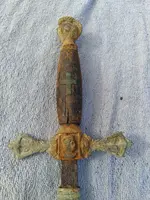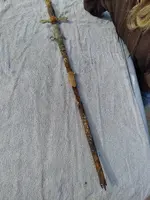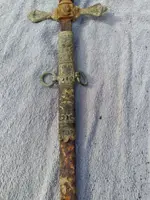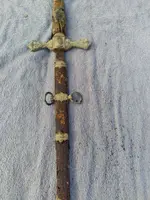You are using an out of date browser. It may not display this or other websites correctly.
You should upgrade or use an alternative browser.
You should upgrade or use an alternative browser.
sword
- Thread starter grisso3
- Start date
- Joined
- Dec 23, 2019
- Messages
- 6,360
- Reaction score
- 20,241
- Golden Thread
- 0
- Location
- Surrey, UK
- Primary Interest:
- All Treasure Hunting
Very cool. It’s Masonic regalia. In addition to the Templar cross and the knight’s head in chainmail on the sword handle, it also has the ‘cross and crown’ emblem on the scabbard.
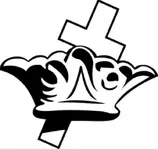
Although each of those emblems have wider use, the three together would have specific association with the Knight Templar degree of the York Rite of Freemasonary
It’s probably too corroded, but often these swords have some helpful information engraved on the blade to help attribute them.

Although each of those emblems have wider use, the three together would have specific association with the Knight Templar degree of the York Rite of Freemasonary
It’s probably too corroded, but often these swords have some helpful information engraved on the blade to help attribute them.
Last edited:
billb
Gold Member
That’s a beautiful recoverya friend found this sword in Kentucky earlier this year . looking for any input . was it ceremonial or actually used for ... . was found in the ground with a few inches os tip sticking out.
Thanks again for sharing your friends treasure
Would this one be a fantasy item/reproduction of an original? (Lost in a play enactment. )Very cool. It’s Masonic regalia. In addition to the Templar cross and the knight’s head in chainmail on the sword handle, it also has the ‘cross and crown’ emblem on the scabbard.
View attachment 2057824
Although each of those emblems have wider use, the three together would have specific association with the Knight Templar degree of the York Rite of Freemasonary
It’s probably too corroded, but often these swords have some helpful information engraved on the blade to help attribute them.
Something like the Civil War buttons folks find that are lost because of the enactment
I was detecting in the ravines/forest section of a large park system.
Next thing I knew it was like being casted back into the medieval times.
Folks running around with swords-dressed in period clothing-it was kind of weird.
Messed with my detecting mojo bad-I left, as there must of been 30-40 running around the site.
- Joined
- Feb 9, 2020
- Messages
- 8,031
- Reaction score
- 16,242
- Golden Thread
- 0
- Location
- Eastern Ohio
- Detector(s) used
- XP Deus
XP Deus 2
Minelab E-Trac
- Primary Interest:
- Metal Detecting
Very cool !
- Joined
- Dec 23, 2019
- Messages
- 6,360
- Reaction score
- 20,241
- Golden Thread
- 0
- Location
- Surrey, UK
- Primary Interest:
- All Treasure Hunting
Would this one be a fantasy item/reproduction of an original? (Lost in a play enactment. )
I don’t see any particular reason to believe it’s a replica or fantasy item. The most likely possibility for Kentucky would be the Grand Commandery of Kentucky Knights Templar (York Rite) founded on 5th October 1847 and still in existence today. Scroll down to the pictures and pretty much all of the big cheeses are shown with a ceremonial sword:
https://www.yorkriteky.org/grandcommandery/
It might be worth dropping them a line (there’s an email address on the ‘contact’ page) to see if they can provide any additional information.
- Joined
- Aug 19, 2014
- Messages
- 39,000
- Reaction score
- 143,642
- Golden Thread
- 0
- Location
- Tarpon Springs
- Detector(s) used
- JW 8X-ML X2-VP 585
- Primary Interest:
- All Treasure Hunting
Masonic Knight / Templar - dress / ceremonial sword.
Here are similar ... yours might be a Henderson Ames Company one... check for marks.


Here are similar ... yours might be a Henderson Ames Company one... check for marks.
Last edited:
iAmMike
Hero Member
- Joined
- Oct 31, 2021
- Messages
- 778
- Reaction score
- 2,450
- Golden Thread
- 0
- Location
- North Georgia, USA
- Detector(s) used
- MineLab Equinox 800, Manticore
That is an absolutely incredible find!
grisso3
Jr. Member
- #11
Thread Owner
part of the scabbard has come loose on the bottom of the sword. ill see if we can look. any idea of age ? thanksVery cool. It’s Masonic regalia. In addition to the Templar cross and the knight’s head in chainmail on the sword handle, it also has the ‘cross and crown’ emblem on the scabbard.
View attachment 2057824
Although each of those emblems have wider use, the three together would have specific association with the Knight Templar degree of the York Rite of Freemasonary
It’s probably too corroded, but often these swords have some helpful information engraved on the blade to help attribute them.
mjb Mike
Hero Member
- Joined
- Feb 10, 2021
- Messages
- 843
- Reaction score
- 2,329
- Golden Thread
- 0
- Location
- southern mayland
- Primary Interest:
- All Treasure Hunting
wow very cool find
Blak bart
Platinum Member
Wow....what a great piece for the wall/mantle !! Hang it in the man cave !!
- Joined
- Dec 23, 2019
- Messages
- 6,360
- Reaction score
- 20,241
- Golden Thread
- 0
- Location
- Surrey, UK
- Primary Interest:
- All Treasure Hunting
part of the scabbard has come loose on the bottom of the sword. ill see if we can look. any idea of age ? thanks
Tough to date unless you can find a maker mark or a personalised inscription for the owner. A nickel (or silver) plated scabbard indicates the sword belonged to a ‘Sir Knight’, while a gold plated one is for a ‘Commander’. If it’s ‘local’ to Kentucky, then the first (I think) establishment of a Knights Templar commandery in Kentucky was in 1847 as I said above. As ARC suggests, the most likely manufacturer would be Henderson Ames or one of its predecessors or successors. They have a long history as suppliers of Masonic and other fraternal swords under multiple names. Broadly:
1850-1871: Frank Henderson
1871-1873: Henderson and Giddings
1873-1893: Frank Henderson
1893-1923: Henderson Ames
1923-1925: The M. C. Lilley and Company
1925-1931: The Lilley Company
1931-1951 : Lilley-Ames Company
Those aren’t the only possibilities though, and the design imagery is not unique to particular makers or time periods, but rather part-and-parcel of the Templar heritage.
It’s curious that this was a dug item. It’s not the kind of thing you could easily lose, nor something likely to have been simply thrown away. There’s no particular ritual tradition for Masonic swords being deliberately buried either. The funeral rite is for the sword to be displayed on top of the coffin, removed before burial, and passed to the owner’s family. Were there any dwellings or other buildings (or ruins of them) in the vicinity of the find that might give a clue to why it was there?
Last edited:
Similar threads
- Replies
- 11
- Views
- 838
- Replies
- 16
- Views
- 885
- Replies
- 3
- Views
- 659
Users who are viewing this thread
Total: 1 (members: 0, guests: 1)
Latest Discussions
-
$1000 Buried on the Prairies near Cheyenne 1910
- Latest: Prairie Gazingfox
-
-
-
-



